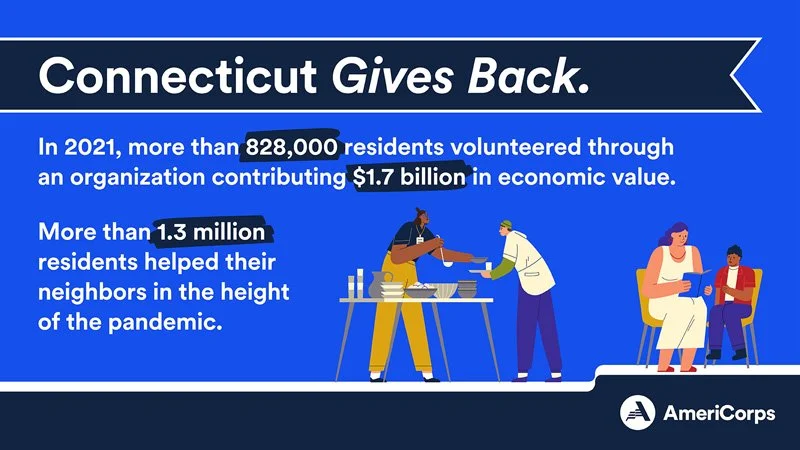Volunteerism, Formal and Informal, Peaked in CT During Height of Pandemic
/Every two years, AmeriCorps conducts the most robust longitudinal survey about volunteerism and other forms of civic engagement in the United States in partnership with the US Census Bureau. The latest data, for 2020-2021, was released early this year.
The data informs Volunteering and Civic Life in America, AmeriCorps’ comprehensive report about civic engagement trends in the United States. The latest report examines organizational volunteering, helping others informally, charitable giving, and other civic behaviors from September 2020-2021, at the height of the COVID-19 pandemic.
According to the research, Americans of all ages and backgrounds contributed countless hours to their communities through formal and informal volunteerism between 2020 and 2021 during the global COVID-19 pandemic. Nearly 51 percent of Americans, or 124.7 million people, informally helped friends, neighbors, or community members at least once a month.
Additionally. more than 23 percent of Americans, or 60.7 million people, formally volunteered, giving more than 4.1 billion hours of service with an estimated economic value of $122.9 billion.
In Connecticut, according to the data:
828,410 formal volunteers contributed 50.1 million hours of service through organizations worth an estimated $1.7 billion
28.8% of residents formally volunteered through organizations
97.5% of residents talked to or spent time with friends or family
50.2% of residents informally helped others by exchanging favors with their neighbors
70.7% of residents had a conversation or spent time with their neighbors
22.4% of residents belonged to an organization
61.5% of residents donated $25 or more to charity
Formal volunteering involves helping others through organizations and includes activities like supporting COVID-19 testing, immunization, and other public health efforts, conducting wellness checks on isolated seniors, supporting food banks, and providing virtual tutoring and mentoring to help students stay on track in school, according to AmeriCorps and the U.S. Census Bureau. Informal helping involves helping others outside of an organizational context, including doing favors for neighbors like house sitting, watching each other’s children, lending tools, running errands, and other things to lend a hand.
Connecticut did not earn a place among the top ten states in formal or informal volunteering, but was above the national average in formal volunteering and on a par with the national average in informal volunteering.
The national data indicate that the formal volunteering rate for women dropped eight percentage points—for men it dropped five percentage points. Still, women continued to volunteer at a higher rate than men. Generation X (aged 41 to 56 in 2021) had the highest formal volunteering rate out of all generations (27 percent). Parents with children under 18 formally volunteered at a higher rate (30 percent) than those without children in their household (21 percent).
National demographics also indicated that Baby boomers had the highest informal helping rate (59 percent) of all generations; veterans helped their neighbors at a rate of 59 percent, eight percentage points higher than non-veterans; and people with children under 18 informally helped their neighbors at a higher rate (58 percent) than those without children in their household (49 percent).
































